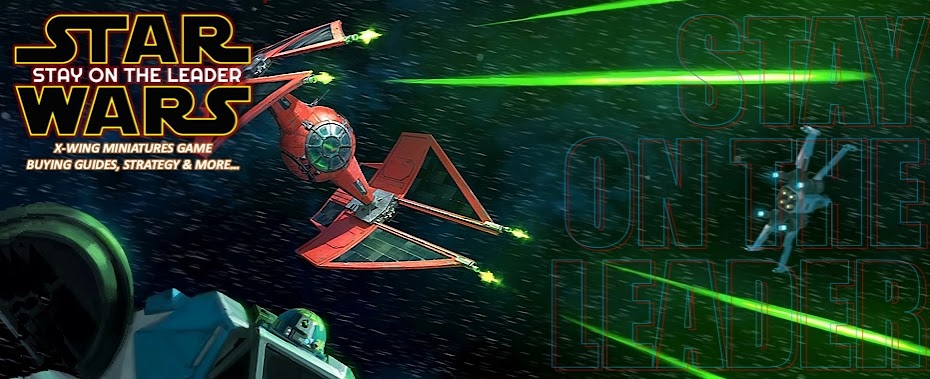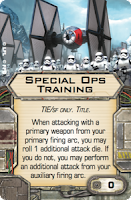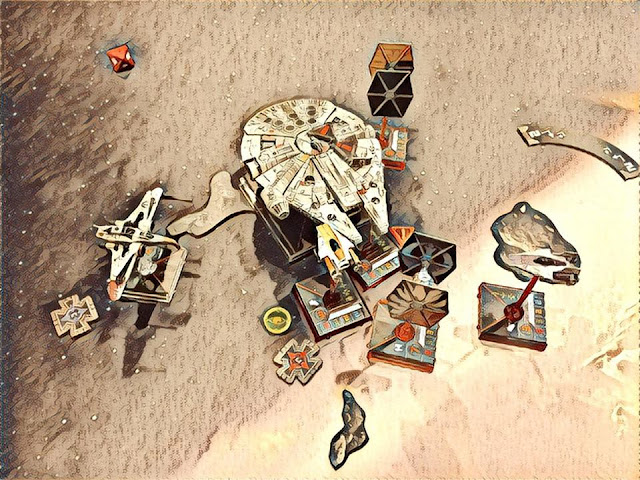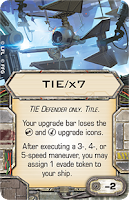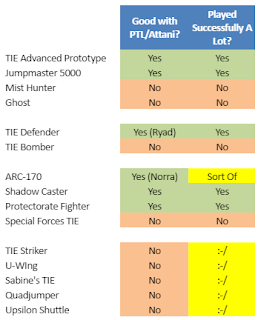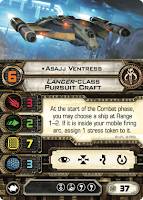In the first part of this 'State of the Game' review I looked at some of the common problems players are raising with how the competitive side of X-Wing has developed recently. In this second part I'm going to look at how players who are feeling the pinch can try to weather the storm.
Patience You Must Have
If you're not enjoying what the tournament X-Wing metagame looks like right now then the easiest solution (in the sense that you don't have to do anything) is just to sit tight and wait for things to get better. You're going to maybe have a rough few months but just go with it, maybe even switch to playing Paratanni yourself. Wave 10 hasn't really been digested by the player base yet so maybe somebody will come up with a squad that switches the metagame around, maybe there's going to be something in the next Wave, who knows?
The downside with this is that I recognise that a lot of players have basically already been doing this for nearly a year already. When Soontir/Palpatine ran riot last year they sat and waited patiently, then it was Triple Jumpmasters and they sat and waited patiently, then it was Dengaroo and they sat and waited patiently, then it was /x7 Defenders and now it's Paratanni.
It's been a looooong long time since the game looked very much like what a significant portion of the player base want it to look like. Ever since Palpatine pushed the green defence dice of Soontir Fel over the top there's been little room for any of those players wanting to push around the likes of X-Wings and B-Wings. That's not what the game's about any more at the top level, and it hasn't been for a while now.
Patience is a virtue, they say, but if there's no reward for that patience then it can be hard to maintain your zen focus indefinitely.
Into Exile I Must Go. Failed I Have
If tournament X-Wing is your problem then, just... stop playing tournament X-Wing. It doesn't have to mean stopping playing X-Wing altogether, though. One of the cruel ironies of the current situation, to my mind, is that once you get away from all the hyper-tokened dice-inflationed power surge of Waves 8 & 9 the rest of the game is actually in a pretty good place!
- Heroes of the Resistance gave us some fun new T-70 X-Wing pilots along with a new take on the Millenium Falcon. The ARC and Sabine's TIE given Rebel players all new strategies and Crew/Astromech combinations to explore, while the Ghost expansion is still a triumph of thematic design with so many different configurations available.
- Imperial Veterans might have brought the accursed /x7 title but if you pretended that card wasn't in the box then the /D title and the new pilots give you a good reason to use TIE Defenders for the first time, and even TIE Bombers might be worth a look (I'm a big fan of Deathfire). The Upsilon Shuttle is a big brawler you can kit out in different ways, the TIE/sf's rear arc mean it flies in very different ways to anything else the Imperials have, and the TIE Striker whizzes about in crazy shapes and is fun to fly.
- Scum might have been turbocharged through Waves 8 & 9 but at least now they're playable! Attani Mindlink does have some uses that aren't completely absurdly good, the Scyks got a buff, the Shadow Caster is actually pretty balanced when it's not loaded down with Attani Mindlink or Push The Limit and the new Quadjumper is a delicious dose of jankiness.
The top tier tournament lists might completely wipe the floor with almost anything I just discussed, but if you're not playing with/against the top tier lists then there's actually an awful lot of good stuff to explore and enjoy.
This has been my path the last couple of months. I worked out that the enjoyment I got from both attending tournaments and playing against players who were practicing for tournaments simple wasn't worth my time. There's a great saying that dates back to medieval times which is "the game's not worth the candle" and what that saying means is that, back in the olden days you'd be playing a game in the inn but you'd need light to play by so you'd have to buy a candle. When the candle ran out halfway through the game you'd need to buy another, but if you weren't enjoying the game then you'd just give up on it rather than waste money on a candle. And that's how I felt about playing X-Wing against the strongest lists.
My local metagame is quite competitive - in my immediate test group we had a couple of players who made Top-16 at Worlds last year - but I was fortunate enough to have other players I could seek out who weren't dedicating themselves to trying to compete for as many prizes or wins as they could achieve. Now I'm enjoying playing a lot more because I get to experiment and play the lists I want to play instead of the lists I need to play.
The only real downside for me, as somebody who likes to create his own squads and trying to find new ways to attack the metagame, is that I've always got that nagging question of 'I keep winning with this thing... is it actually properly good?'. Without pitting myself against those players and squads that I'm specifically avoiding then it's impossible to tell. Is my new squad another Sutcliffe Sligh (the first deck to win a major Magic even for a UK player) or is it another Death Star (a deck so named because it always blew up seconds before it won).
If I turn that part of my brain off then so long as I'm enjoying playing the game does it really matter if I've accidentally blown the world of X-Wing wide open or not? No, it doesn't.
Organised Fun
I would always have championed Organised Play structures in the past as one of the best ways to jump into a game. I know a lot of new players are terrified of setting foot into a tournament but usually it's the best way to meet people who play the same game as you and have the same interests. Yeah you'll probably lose a bunch of games but what you gain from the experience is much more valuable.
BTW if anyone reading these blogs is coming away going "well, I was going to play in my first tournament until I read this but not a chance now!" then: please, go anyway and make those friends. You'll probably lose bunch of games if it's your first time, you may well even meet some people who don't play the game in a way you want to play it, but you're also going to meet people who DO play the game the way you want to play. Go and meet them, it's worth it in the long run. Trust me.
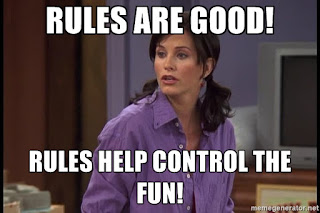 Another advantage that Organised Play structures have is that everyone there knows what the rules are and is, ostensibly, there for the same thing: to try and win. The rules of the tournament say what is allowed and what isn't, and it's usually a pretty clear black and white about what's acceptable. Often when you play in casual settings that black and white clarity becomes very muddled. As an experienced tournament player who has recently dropped down to playing more casually I'm taking care to 'pull my punches' a bit both in the squads I make and sometimes even in how I play them on the table - the game experience of my opponent is more important to me than whether I win or lose.
Another advantage that Organised Play structures have is that everyone there knows what the rules are and is, ostensibly, there for the same thing: to try and win. The rules of the tournament say what is allowed and what isn't, and it's usually a pretty clear black and white about what's acceptable. Often when you play in casual settings that black and white clarity becomes very muddled. As an experienced tournament player who has recently dropped down to playing more casually I'm taking care to 'pull my punches' a bit both in the squads I make and sometimes even in how I play them on the table - the game experience of my opponent is more important to me than whether I win or lose.
But how much should I pull those punches by, and should I be unhappy if my less experienced opponents bring the tournament quality lists I'm trying to avoid playing against? Without the framework of a tournament finding that 'sweet spot' where both players enjoy the game involves a bit more of a dialogue between everyone to try and work out quite where the power level of those games are being set at.
This is where other clearly-defined modes of play can come in, such as Epic, Hangar Bay, or playing the Missions that come with the various expansions. Alternatively you can come up with your house rules for what is allowed and what isn't. FFG had an article last year about different ways of playing to take a break from hardcore tournament deathmatches that covers a lot of this ground so I'm not going to go into too much depth, I'm just going to point you to it and let you go have a read of that.
The main thing that the FFG article doesn't really touch on is Heroes of the Aturi Cluster, which is a fan-created campaign mode for X-Wing. I can't give it a personal thumbs up as I've not tried it, but it gets talked about in such glowing terms that it might well be worth a look if you're searching for new ways to play X-Wing than standard 100pt deathmatch games.
There Are Alternatives To Fighting
We're very used to looking towards FFG for how the game develops, putting everything on them and their organised play team to manage and maintain the game in an enjoyable state. Those wheels can turn painfully slowly, though, and at this point it's probably fair to say that the lack of responsiveness from FFG is now feeding into the problem as much as it's solving it. Players have been calling so consistently for a T-65 X-Wing buff for so long, for instance, yet never got a whiff that their concerns were even being heard let alone taken seriously or acted on.
FFG prefers to act on metagame issues through releasing new cards to attack strategies that are too popular. This works in the end but it can be an incredibly slow process, taking 18 months between a problem being identified and a solution getting into players hands (via design, playtesting, printing, and the inevitable 'Boat Phase'). I went through this process when I played Netrunner, with years of critical design issues being unsuccessfully corrected through releasing new expansions. Finally, Netrunner changed designers and they acted to restrict the problem immediately cards through errata and new deckbuilding rules.
 |
| After years of failing to fix basic Core Set issues Netrunner's 'Most Wanted' list made key cards more expensive to use. |
So all the evidence is that waiting on FFG to fix something is likely to require an awful lot of patience, and even then it might never happen. One option, therefore, is to cut FFG out of the loop and put the power into the hands of the community.
This probably sounds like a real homespun route doomed to die a slow death without support from FFG. Amazingly, though, there are numerous examples where this has been successful, and ultimately led to the community's changes being adopted by the people who make the game.
- Perhaps the most significant example is Magic: The Gatherings 'Commander' format. For years Commander was a casual-only format that was played a loooong way from anything competitive. I knew it under it's old name of 'Elder Dragon Highlander' format and most of the players who I saw playing it were actually judges at big events, winding down after a long day of rules questions and player management by flinging crazy theme decks at each other in the hotel bar. It wasn't just a random format, though, the community came together to create a rules committee for deciding the appropriate banned & restricted cards to make it a fun way to play. Ultimately Elder Dragon Highlander proved to be a bit of a clumsy name but 'Commander' stuck and it was adopted by WotC as an official format and even led to a raft of specific Commander products and decks being printed. From casual fan-made format to bespoke official expansions, Commander made it all the way to the promised land!
- In miniatures game there is the example of Blood Bowl and its Living Rulebook, which curated the rules and structure of Blood Bowl for the 15 years that it was effectively ignored by Games Workshop. A mix of Games Workshop staff and players, the Blood Bowl Rules Committee helped to keep the game alive and healthy through six editions of the Living Rulebook, bringing in new teams, players, rules, skills, everything. So successful was the Living Rulebook project in keeping the game of Blood Bowl alive that ultimately a couple of official video games were made that restored some of the game's profile, and then finally Games Workshop caved in and re-launched the game at the back end of 2016.
- Another example, back to Magic, is of what we now know as the Legacy format - one of the formats that allow players to use cards from pretty much the entire 25 year history of the game. Originally, though, Legacy was known by the catchy name of 'Type 1.5' and it was the bastard child of 'Type I' (which let you use everything) and 'Type II' (which was rotating the two most recent years of expansions). That it only got the moniker of Type 1.5 showed just how much of an afterthought the format was and it was pretty much entirely unsupported. Without official support the Type 1.5 player community set up their own system of tournaments and kept it all ticking over. Years later, when WotC were faced with the problem of trying to bridge the huge gap between 'Type I' and 'Extended' (like Standard but with five or six years of expansions, rather than just two) they saw that Type 1.5 had a following, dusted it off and gave it a dedicated Banned/Restricted list and official tournaments - the popular Legacy format was born.
A more general example from Magic was the formation of the Casual Player's Alliance (CPA) around 1999/2000 when the game went through a bit of a sticky patch of unpleasant overpowered combo decks. The CPA had no specific agenda and championed no specific formats or playstyles, they just wanted to be a home for players who wanted to be able to talk Magic away from the competitive strategy chat that dominated on the main websites. These days visiting the CPA is a lot like walking through an old abandoned hotel, with only a few guests and staff left shuffling around its dusty halls, but the fact that it's so quiet in the CPA today is largely because, well... they won. WotC recognised that the competitive metagame they had created was unpopular with a large portion of their player base and refocused their future sets on changing that fact. By 2002/2003 the CPA's unique purpose was no longer essential and as old members drifted away over time the site wound down.
What this all demonstrates is that community action can successfully curate a game or format of play. Indeed,there are examples above of times when they've been able to do that more successfully than the company who made the game! Often this is because those players communities cared more about the key issues of that niche interest than the company who had to spread their attention across a broader canvas.
Will it definitely be a success? No. But can it be? Yes, certainly.
The Man Who Would Be King
So much for various things that you could do in response to the current situation. This is my blog so I'm putting myself in charge... what would I do to try and reshape the competitive tournament format to one that would make me want to return to playing in tournaments?
In the last part of this two-parter blog I identified four problem areas. Let's take a working hypothesis forwards for what we need to solve:
- FFG are not cynically cranking up the power level but attempting to churn ships in and out of fashion, Wave 8 & 9 just happened to feature some mistakes in how much they felt they needed to buff things up that were previously underplayed.
- Some added complexity is inevitable and healthy for a game to not stagnate, but an ever-growing card pool produces increasing potential for unhealthy card combinations.
- The valid options for competitive ships have been restricted significantly by the dominance of action-economy engines that can't be easily disrupted, as they are the most cost-effective. Re-emphasise the importance of the Planning Phase.
- We want it to 'feel like Star Wars' and to see ships from the films used in games more often.
Solutions to propose:
- Nerf some specific Wave 8/9 cards to flatten them back towards other waves and open up more valid squad choices. As players: if our favourite ship isn't hot right now then be patient and trust that its time will come.
- Rotate non-title upgrades from older waves out of the game, reprint the ones you want to see remain available beyond their rotation date. Keep a manageable limit on the complexity of interactions within the upgrade pool.
- Nerf or remove specific action economy options that are either especially efficient or especially difficult to disrupt. Buff or design cards that reward or facilitate good positioning.
- When balance is concerned err on the side of boldness with the most 'iconic' ships and pilots to ensure they're less likely to become obsolete as the ships churn.
I want to look at these out of order. By far the most impactful change would be to begin rotation of upgrades from earlier waves, which would remove dozens of cards from the competitive cardpool.
- All ship-specific Titles and upgrade cards remain 'Evergreen' and do not rotate out of use (eg. Slave I, Millenium Falcon, Chardaan Refit, Bomb Loadout)
- All Unique Crew remain 'Evergreen' and do not rotate out of use (eg. Darth Vader, C-3PO, Rebel Captive)
- All other Upgrade cards that do not appear in expansions from Rebel Aces/Wave 5 onwards are rotated out of use immediately following the World Championships.
- Each year the World Championships will rotate out a successive two waves of upgrades
There are a few dozen upgrades in Waves 1-4 that have not been reprinted in Waves 5+ and would be lost from the cardpool. Most of these cards would not really be badly missed (Swarm Tactics, Elusiveness, Blaster Turret, Ion Pulse Missiles, Decoy) but there are some tournament level staples that would rotate out of use and these changes alone would have huge potential to shake up the metagame.
Originally I was not keeping the unique Crew cards 'Evergreen' but when I looked at that list it seemed to be in direct opposition to the 4th objective of the changes, which is keeping it feeling like Star Wars. If that was an objective for these changes then I didn't want to be the guy responsible for killing off Lando Calrissian, or consigning C-3PO to the scrapheap!
The list cards not printed since Wave 4 that would rotate out includes:
- R2-D2 (astromech)
- R5-P9
- R3-A2
- R4-D6
- Push The Limit
- Fire Control System
- Tactician
- Advanced Sensors
If FFG adopted a rotation system like this then some of these cards could be reprinted in future expansions, or have new version printed. If it's a community-run list then when it's gone it's gone, though.
Next up after that rotation the priority would be to try and trim the worst power excesses Wave 8 & 9 down a little. I don't think there needs to be drastic changes in most cases, just gentle tweaks. What I'm limiting myself to doing with this is some minor points adjustments to cards, I'm leaving FAQ or card rewrites out of scope because that creates a whole new set of problems!
- Attani Mindlink - I can't remember the last time I saw something go from cute to terrifying in such a short space of time. Attani Mindlink is winning pretty much everything in sight, and as it's Scum-only this is warping the whole game around that faction. At the recent Yavin Open 48% of lists that made Day 2 were Scum and 68% of the lists with 6+ wins at that point were Scum. By the time it got to the Top-8 it was 88% Scum. I really like a recent suggestion to make Attani Mindlink Small Ship Only, which might help return it to that cute card I want to play with, but without that errata I think it needs tuning down a notch in the sheer efficiency it offers.
- Extra Munitions - Extra Munitions is one that is trying to get ahead of future problems as much as solving current ones like the mass K-Wing bombing lists. Wave 8 & 9 has finally given us lists with viable Ordnance but what it's also demonstrated is that viable Ordnance tends to lead to pretty annoying lists that overpower a lot of other ships. Increasing the cost of Extra Munitions doesn't make Ordnance worse per se, but does make it a little harder to rely on it entirely and hopefully encourages more balanced listbuilding.
- /x7 - The TIE Defender has replaced the vast majority of other Imperial ship choices and for the sheer sake of diversity it needs to be reined in. By removing the points discount TIE Defender players now have a straight choice between extra defense with /x7 or extra firepower with /D, and a whole host of other Imperial ships come back into the discussion.
- Zuckuss - As I've discussed in more detail already I think Zuckuss is simple bad design. It's clear that we can't rely on the 'stress cost' to control Zuckuss' use, so I'm adding to the points cost significantly. Frankly I'm one step short of banning it entirely, but at least now you have to pay a fair points cost for the effect once you've built a ship that can accommodate the stress.
Thirdly: trying to rebalance the mechanics of the game, although a lot of this has I think been already achieved by rotating out cards like Push The Limit, and increasing the cost on the most recent action economy cards like Attani Mindlink and /x7. Above is a list of points changes I would make with this intention, and I've tried to keep the list very brief rather than go point-by-point through every upgrade and rebalance it.
Really here I'm focusing on slightly increasing the price of four upgrades that I think get played a lot, and in particular those that either reduce the importance of positioning (turreted ships: TLT, Gunner) or provide offense that threatens to overwhelm the defences of smaller ships (Crack Shot, Gunner). I'm also making a few other less-played cards cheaper to try and encourage their use as viable options (a carrot to go with the stick).
The final part of the problem - making the iconic ships more attractive - is the hardest to fix retrospectively, especially without getting into FAQ or errata, improving dials, creating new titles for old ships etc. I'm not going to try tackling that problem other than to propose a very simple but sweeping change:
- All Unique pilots from Wave 1-3 have their points cost reduced by -1pt.
 This is a pretty minor change but it might give you more reason to bring in those iconic pilots from the earlier ships and put them onto the table - assembling a thematic 'Rogue Squadron' of X-Wing pilots would be easier then ever, for example. There are a few notable tournament staples who get a little bit cheaper (Biggs, Howlrunner, Han Solo, Darth Vader) but that there's so few Wave 1-3 pilots we're seeing played really just highlights how much everyone else around them needs that bit of extra help. Yes Biggs Darklighter gets cheaper, but as all his most comment Astromech options just rotated out with Waves 1-4 maybe that's not such a problem after all?
This is a pretty minor change but it might give you more reason to bring in those iconic pilots from the earlier ships and put them onto the table - assembling a thematic 'Rogue Squadron' of X-Wing pilots would be easier then ever, for example. There are a few notable tournament staples who get a little bit cheaper (Biggs, Howlrunner, Han Solo, Darth Vader) but that there's so few Wave 1-3 pilots we're seeing played really just highlights how much everyone else around them needs that bit of extra help. Yes Biggs Darklighter gets cheaper, but as all his most comment Astromech options just rotated out with Waves 1-4 maybe that's not such a problem after all?
So... those are my changes, and what format would it create? No Rebel Regen, no Push The Limit, Attani Mindlink is double the price and Scum can't use Zuckuss so easily. There's fewer card combinations to worry about and the most iconic named pilots in Star Wars are cheaper than ever.
Instant fix? Hell no, I'm sure it would take more than myself on my own with an evening to spare in front of a word processor but, y'know... it seems like a start.
Instant fix? Hell no, I'm sure it would take more than myself on my own with an evening to spare in front of a word processor but, y'know... it seems like a start.
